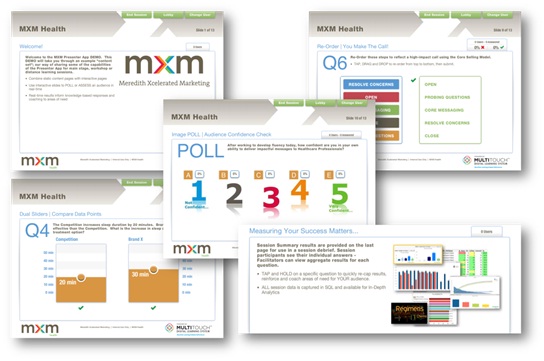Bringing pharma sales training to life with digital technology

In the final part of this series on how digital engagement techniques play a vital role in pharma sales force training, MXM Health explores how traditional training events can be brought to life with interactive technology and careful planning.
Continued from 'Using mobile technology and gamification to empower pharma sales'
So far in this series, we have looked at how sophisticated and personalized digital engagement techniques, which are commonly used in external communication with prescribers and consumers, can also be employed for internal sales force training. For example, remote training via mobile devices and methods such as gamification can deliver improved and continual learning.
But this does not mean traditional sales training event is dead! Far from it; these meetings are a critical component of facilitating shared learning, by bringing together personnel with different skills and experiences. They can, however, be enhanced by digital technology to maximize the impact of taking reps out of territory.
"When it comes to application of selling skills, and communication between two people, nothing can replicate face-to-face practice."
Physical interaction is still valuable in the digital world
Most pharma companies hold sales meetings once or twice yearly, where everyone gets together in one place. Although these meetings can be expensive in terms of 'lost' sales time, various benefits are realized: consider that events are not solely training events but also serve to motivate or reward teams, senior management can communicate key messages en masse, and hallway conversations that drive innovation and sharing are activated throughout the event. Here, facilitating learning shares time with other priorities, but that does not limit the opportunity to drive Engagement To Action through training.
Live events present the opportunity for specific learning and performance touchpoints, within the context of continual learning powered by digital solutions. When it comes to application of selling skills, and communication between two people, nothing can replicate face-to-face practice. Even facetime integration or virtual practice does not capture body language and personal communication nuances that could be the difference between winning a client over or turning them off.
However, weaving small group interactivity, digital engagement, and social audience solutions, focused on team challenges or competitive activities, into an event activates powerful learning processes. Interestingly, live engagement supported by interactivity will raise the energy level, and the sticky factor, for training built around the same principles of learning design, behavioral objectives and performance-driven outcomes that we suggested for designing impactful gamification!
Planning ahead to maximize event-based learning
Without the right planning, most events will unfortunately end up as didactic presentation-oriented affairs. Selecting the right venue, incorporating the right technology, and building behavioral learning design in advance is critical.
Ensuring you have the right space available is an important consideration. Having one big room is great for large group presentations, but does not facilitate the smaller group activities where real learning takes place. Breakout space, informal conversation space, and technology-connected spaces at events are necessary to maximize engagement, and results. Different types of space encourage more creative thinking – and more creative learning design - that cannot be achieved in a home office or generic corporate location.
"Technology plays a vital role in successful live events"
Technology plays a vital role in successful live events, so WIFI planning, production partnerships, and venue internet connectivity need to be coordinated with learning design. In addition, having the right hardware and software built into event training design from 'day 1' will also help deliver on the promise of shared lessons from more impactful sessions and encourage interaction between coaches, experts and learners.
For example, new applications are available to facilitate real-time feedback between the presenter and the audience using mobile devices such as iPads. Those observing can provide questions and comments, respond to polls, or vote on additional areas to cover (as outlined in figure 1), allowing the presenter to adapt the session as they go along. This responsive and active facilitation of content, tailored to real-time responses and tracking of learner behavior, ensures that key learning moments are not left behind at an event. This strategy plays to the strengths of enabling learners to get engaged, provide feedback, and learn new information for themselves, rather than being told what they need to know.

Figure 1: iPads can be used to drive active facilitation – interactive content enabling adaptive and personalized training sessions.
Such interactive technology can also play an important role in gathering input from other individuals ahead of such sessions, helping to plan the agenda. There is never one person in a company that holds all the knowledge, so the job of a good trainer is very much about unlocking the expertise from multiple people and sharing it.
"The job of a good trainer is very much about unlocking the expertise from multiple people and sharing it"
Allow learning to continue beyond the event
In the previous article, we quoted the fact that up to 80% of what is learned during live meetings is forgotten within two weeks. For such meetings to be effective this loss must be avoided. Fortunately, there are a number of ways this can be achieved, including:
• Ensuring materials from the event, e.g. case studies, presentations, and videos, are available after the event and actively disseminated.
• Continuing the event sessions with constant remote training, to enhance and reinforce what was learned during the live meeting.
• Setting SMART objectives based on the meeting, and regularly assessing performance against these via remote management.
It is amazing how often the learning from a live event stops when the event ends, though ultimately the desired outcome from live sales meetings, as with any form of training, is that new information translates into a positive change in behavior and performance. We know what works best for achieving behaviour change if we look at the expectations of engagement with customers, so it is time to set expectations for internal learning and performance to the same standard for engagement and access to information. It's time to recognize the value of translating Engagement to Action, to achieve better results.
About the author:
Todd has over 10 years of significant digital expertise and has implemented various integrated digital solutions across enterprise systems and for small specialty businesses with unique business models. As MXM's Digital Team Lead, Todd has a proven history of engaging client leadership, anticipating and understanding business and project needs, and maximizing delivery effectiveness of digital solutions.
MXM Health, part of the broader MXM group, is the premier agency in the health care training and marketing arena, offering full-service learning design and development solutions for the life sciences industry.
Todd Herman can be contacted at +1 248 246 5368 or via email at Todd.Herman@mxm.com.
For more information on MXM Health visit www.mxm-health.com.
How does pharma optimize learning from live sales meetings?












